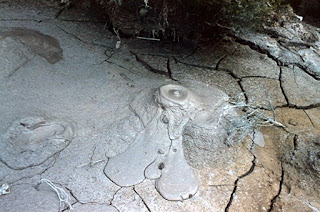March 6, 2018
As the name implies, mud volcanoes are eruptions of mud – not molten rock as in igneous volcanoes. They’re found all around the world, amounting to about a thousand in total number known. The one thing they have in common is hot or at least warm water, so they occur in geothermal areas especially, but they also are found in the Arctic.
They range in size from tiny, just a few meters across and
high, to big things that can cover several square miles. In Azerbaijan some mud
volcanoes reach 200 meters, 650 feet, in height, and around the world many of
them do have conical, volcano-like shapes. But there are others that are just
low mounds, more like a shield volcano.
 |
| A little (15-cm) mud volcano in New Zealand. Photo by Richard Gibson. |
Mud volcanoes can erupt violently, or seep slowly, and
emissions can last from minutes to years. I think it’s fair to think of some of
them as geysers in which the water contains a lot of sediment, while others are
more like thick, viscous muddy warm springs.
Besides water and fine sediment, mud volcanoes often contain
natural gas – most commonly methane, but sometimes carbon dioxide, nitrogen, or
other gases. The pressure of these gases is often the driving force behind
eruptions, and with a hydrocarbon gas like methane present you might think mud
volcanoes would be associated with oil and gas fields, and you’d be right. The
hundreds of mud volcanoes in Azerbaijan and in the adjacent Caspian Sea are in
the midst of the first great oil province to be exploited, and some of the petroleum
deposits there are related to structures in the rocks and sediments caused by
the upward force of the mud, which can bend its confining rocks as it rises,
just as a salt dome can do. And since methane is flammable, often enough there
are flames associated with mud volcanoes. In 2001, near Baku, Azerbaijan,
flames shot 15 meters, near 50 feet, into the air. Gobustan in Azerbaijan is a
World Heritage Site for it
Mark as Played
Popular Podcasts
Stuff You Should Know
If you've ever wanted to know about champagne, satanism, the Stonewall Uprising, chaos theory, LSD, El Nino, true crime and Rosa Parks, then look no further. Josh and Chuck have you covered.
Dateline NBC
Current and classic episodes, featuring compelling true-crime mysteries, powerful documentaries and in-depth investigations. Follow now to get the latest episodes of Dateline NBC completely free, or subscribe to Dateline Premium for ad-free listening and exclusive bonus content: DatelinePremium.com
The Breakfast Club
The World's Most Dangerous Morning Show, The Breakfast Club, With DJ Envy, Jess Hilarious, And Charlamagne Tha God!